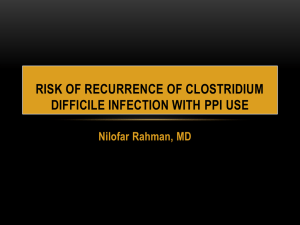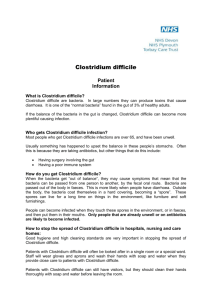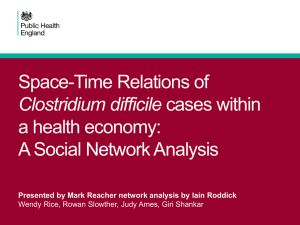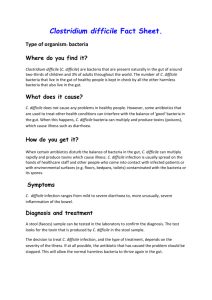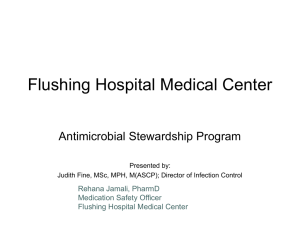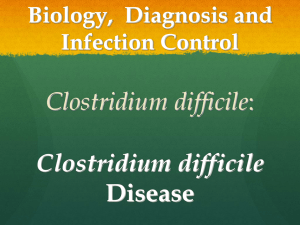References - BioMed Central
advertisement
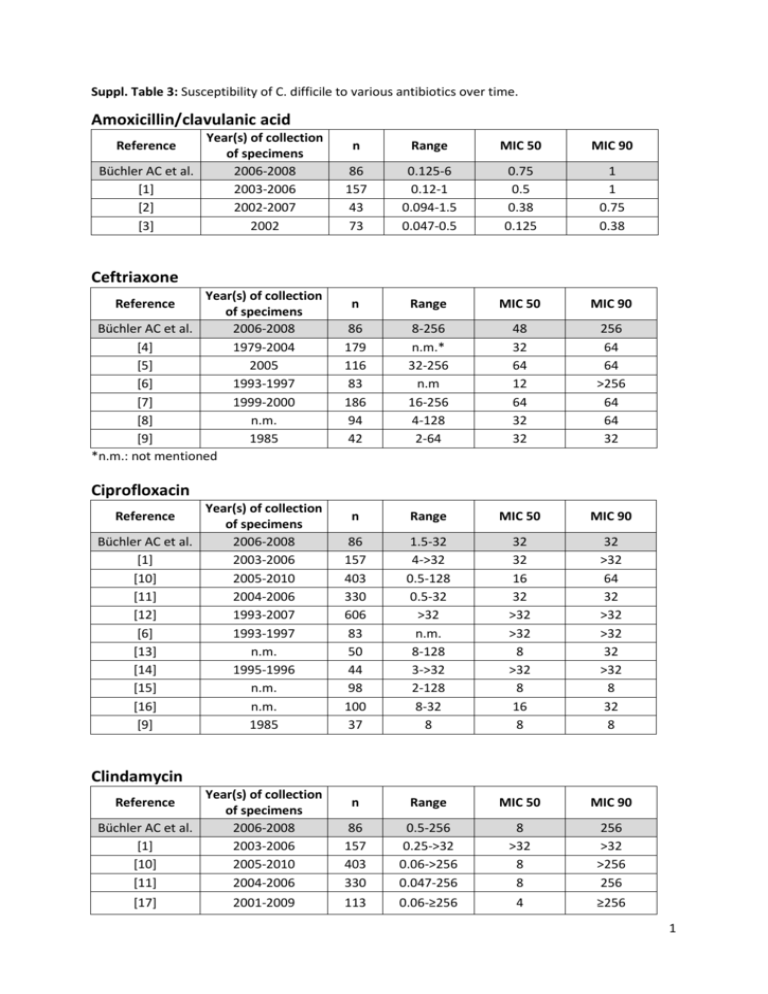
Suppl. Table 3: Susceptibility of C. difficile to various antibiotics over time. Amoxicillin/clavulanic acid Year(s) of collection of specimens Büchler AC et al. 2006-2008 [1] 2003-2006 [2] 2002-2007 [3] 2002 Reference n Range MIC 50 MIC 90 86 157 43 73 0.125-6 0.12-1 0.094-1.5 0.047-0.5 0.75 0.5 0.38 0.125 1 1 0.75 0.38 n Range MIC 50 MIC 90 86 179 116 83 186 94 42 8-256 n.m.* 32-256 n.m 16-256 4-128 2-64 48 32 64 12 64 32 32 256 64 64 >256 64 64 32 n Range MIC 50 MIC 90 86 157 403 330 606 83 50 44 98 100 37 1.5-32 4->32 0.5-128 0.5-32 >32 n.m. 8-128 3->32 2-128 8-32 8 32 32 16 32 >32 >32 8 >32 8 16 8 32 >32 64 32 >32 >32 32 >32 8 32 8 n Range MIC 50 MIC 90 86 157 403 330 0.5-256 0.25->32 0.06->256 0.047-256 8 >32 8 8 256 >32 >256 256 113 0.06-≥256 4 ≥256 Ceftriaxone Year(s) of collection of specimens Büchler AC et al. 2006-2008 [4] 1979-2004 [5] 2005 [6] 1993-1997 [7] 1999-2000 [8] n.m. [9] 1985 *n.m.: not mentioned Reference Ciprofloxacin Year(s) of collection of specimens Büchler AC et al. 2006-2008 [1] 2003-2006 [10] 2005-2010 [11] 2004-2006 [12] 1993-2007 [6] 1993-1997 [13] n.m. [14] 1995-1996 [15] n.m. [16] n.m. [9] 1985 Reference Clindamycin Year(s) of collection of specimens Büchler AC et al. 2006-2008 [1] 2003-2006 [10] 2005-2010 [11] 2004-2006 Reference [17] 2001-2009 1 [2] [12] [4] [18] [5] [19] [20] [6] [21] [22] [22] [7] [23] [3] [14] [24] [24] [15] [8] [25] [9] [26] [27] [28] 2002-2007 1993-2007 1979-2004 2005 2005 2002-2003 2000-2001 1993-1997 n.m. n.m. n.m. 1999-2000 1986-2001 2002 1995-1996 1988-1989 1988-1989 n.m. n.m. 1985-1986 1985 1984 1981 1980 43 606 179 83 116 79 238 83 36 65 28 186 192 73 44 85 46 98 145 100 42 48 79 84 0.016->256 0.5->256 n.m. ≥32 0.5-≥32 0.023-≥256 1->256 n.m. 0.19->256 0.25-3 0.25->256 ≤2->128 2-≥256 0.16->256 2->256 >256 <4->256 <1->128 0.25-≥1024 0.5-128 4-32 0.25->128 0.78->100 <1->128 6 4 16 ≥32 8 4 4 4 >256 1 >256 8 6 4 >256 >256 ≤4 4 8 2 8 >128 3.13 ≤1 >256 >256 16 ≥32 16 256 >256 >256 >256 2 >256 16 ≥256 >256 >256 >256 >256 >128 ≥1024 8 32 >128 >100 128 n Range MIC 50 MIC 90 86 113 43 73 110 0.38-4 0.03-8 0.003-32 0.032-1.0 1-4 1.5 2 0.5 0.75 2 2 4 4 1 2 n Range MIC 50 MIC 90 86 157 403 113 330 43 0.064-2 0.06-1 ≤0.03-4 0.03-4 0.016-1.5 0.016-2 0.25 0.25 0.5 0.5 0.064 0.19 0.75 0.5 0.5 1 0.19 1 Meropenem Year(s) of collection of specimens Büchler AC et al. 2006-2008 [29] 2001-2009 [2] 2002-2007 [3] 2002 [30] 1983-2004 Reference Metronidazole Year(s) of collection of specimens Büchler AC et al. 2006-2008 [1] 2003-2006 [10] 2005-2010 [17] 2001-2009 [11] 2004-2006 [31] 2002-2007 Reference 2 [12] [4] [5] [30] [20] [6] [7] [23] [3] [14] [8] [15] [25] [9] [26] [27] *[28] 1993-2007 1979-2004 2005 1983-2004 2000-2001 1993-1997 1999-2000 1986-2001 2002 1995-1996 n.m. n.m. 1985-1986 1985 1984 1981 1980 606 179 116 110 238 83 186 192 73 44 137 98 100 37 42 79 84 <0.016-2 n.m. ≤0.5-4 0.03-0.5 0.032-8 n.m. 0.5-4 0.06-2 0.023-0.19 0.032-0.5 ≤0.06-8 <1.0 0.064-0.125 0.25-0.5 <0.12-0.25 <0.2-0.39 <1->128 0.25 <0.5 1 0.125 0.125 0.19 1 0.125 0.094 0.19 0.25 <1 0.125 0.5 ≤0,12 0.2 ≤1 0.5 <0.5 2 0.25 0.25 0.38 2 0.25 0.19 0.38 2 <1 0.125 0.5 0.25 0.39 ≤1 n Range MIC 50 MIC 90 86 157 43 83 73 44 1-24 1-32 0.016-24 n.m. 0.047-6 3/4-256/4 6 8 3 1 2 16/4 8 16 6 3 3 >256/4 n Range MIC 50 MIC 90 86 157 403 113 330 43 606 179 116 110 0.75-6 0.12-2 0.06-4 0.25-4 0.023-2 0.25-2 0.25-8 n.m. 1-4 0.06-4 1 0.5 0.5 0.5 0.5 0.5 0.5 1 2 1 1.5 1 1 1 1 1.5 1 2 4 1 * * 1 Stamm 2, 1 Stamm >128 Piperacillin-tazobactam Year(s) of collection of specimens Büchler AC et al. 2006-2008 [1] 2003-2006 [31] 2002-2007 [6] 1993-1997 [3] 2002 [14] 1995-1996 Reference Vancomycin Year(s) of collection of specimens Büchler AC et al. 2006-2008 [1] 2003-2006 [10] 2005-2010 [17] 2001-2009 [11] 2004-2006 [31] 2002-2007 [12] 1993-2007 [4] 1979-2004 [5] 2005 [30] 1983-2004 Reference 3 [20] [6] [7] [23] [3] [14] [8] [15] [25] [26] [27] [28] 2000-2001 1993-1997 1999-2000 1986-2001 2002 1995-1996 n,m. n.m. 1985-1986 1984 1981 1980 236 83 186 192 73 44 138 98 100 42 79 84 0.5-8 n.m. 0.5-4 0.06-4 0.125-3 0.25-1.5 ≤0.125-4 <0.25-8 0.25-16 0.25-1 0.78-1.56 <1 - 8 1 0.25 1 0.75 0.5 0.5 1 2 0.5 0.5 1.56 ≤1 1 0.5 2 1 0.75 1 4 4 1 0.5 1.56 2 References: 1. 2. 3. 4. 5. 6. 7. 8. 9. 10. 11. Kunishima H, Chiba J, Saito M, Honda Y, Kaku M: Antimicrobial susceptibilities of Clostridium difficile isolated in Japan. J Infect Chemother 2013, 19(2):360-362. Jamal W, Shahin M, Rotimi VO: Surveillance and trends of antimicrobial resistance among clinical isolates of anaerobes in Kuwait hospitals from 2002 to 2007. Anaerobe 2010, 16(1):1-5. Jamal WY, Mokaddas EM, Verghese TL, Rotimi VO: In vitro activity of 15 antimicrobial agents against clinical isolates of Clostridium difficile in Kuwait. Int J Antimicrob Agents 2002, 20(4):270-274. Taori SK, Hall V, Poxton IR: Changes in antibiotic susceptibility and ribotypes in Clostridium difficile isolates from southern Scotland, 1979-2004. J Med Microbiol 2010, 59(Pt 3):338344. Mutlu E, Wroe AJ, Sanchez-Hurtado K, Brazier JS, Poxton IR: Molecular characterization and antimicrobial susceptibility patterns of Clostridium difficile strains isolated from hospitals in south-east Scotland. J Med Microbiol 2007, 56(Pt 7):921-929. Samore MH, Venkataraman L, DeGirolami PC, Merrigan MM, Johnson S, Gerding DN, Carmeli Y, Harbarth S: Genotypic and phenotypic analysis of Clostridium difficile correlated with previous antibiotic exposure. Microb Drug Resist 2006, 12(1):23-28. Drummond LJ, McCoubrey J, Smith DG, Starr JM, Poxton IR: Changes in sensitivity patterns to selected antibiotics in Clostridium difficile in geriatric in-patients over an 18-month period. J Med Microbiol 2003, 52(Pt 3):259-263. Wust J, Hardegger U: Studies on the resistance of Clostridium difficile to antimicrobial agents. Zentralbl Bakteriol Mikrobiol Hyg A 1988, 267(3):383-394. Chow AW, Cheng N, Bartlett KH: In vitro susceptibility of Clostridium difficile to new betalactam and quinolone antibiotics. Antimicrob Agents Chemother 1985, 28(6):842-844. Liao CH, Ko WC, Lu JJ, Hsueh PR: Characterizations of clinical isolates of clostridium difficile by toxin genotypes and by susceptibility to 12 antimicrobial agents, including fidaxomicin (OPT-80) and rifaximin: a multicenter study in Taiwan. Antimicrob Agents Chemother 2012, 56(7):3943-3949. Pituch H, Obuch-Woszczatynski P, Wultanska D, Nurzynska G, Harmanus C, Banaszkiewicz A, Radzikowski A, Luczak M, van Belkum A, Kuijper E: Characterization and antimicrobial susceptibility of Clostridium difficile strains isolated from adult patients with diarrhoea hospitalized in two university hospitals in Poland, 2004-2006. J Med Microbiol 2011, 60(Pt 8):1200-1205. 4 12. 13. 14. 15. 16. 17. 18. 19. 20. 21. 22. 23. 24. 25. 26. 27. 28. 29. Noren T, Alriksson I, Akerlund T, Burman LG, Unemo M: In vitro susceptibility to 17 antimicrobials of clinical Clostridium difficile isolates collected in 1993-2007 in Sweden. Clin Microbiol Infect 2010, 16(8):1104-1110. Wilcox MH, Fawley W, Freeman J, Brayson J: In vitro activity of new generation fluoroquinolones against genotypically distinct and indistinguishable Clostridium difficile isolates. J Antimicrob Chemother 2000, 46(4):551-556. Cheng SH, Chu FY, Lo SH, Lu JJ: Antimicrobial susceptibility of Clostridium difficile by E test. J Microbiol Immunol Infect 1999, 32(2):116-120. Clabots CR, Shanholtzer CJ, Peterson LR, Gerding DN: In vitro activity of efrotomycin, ciprofloxacin, and six other antimicrobials against Clostridium difficile. Diagn Microbiol Infect Dis 1987, 6(1):49-52. Delmee M, Avesani V: Comparative in vitro activity of seven quinolones against 100 clinical isolates of Clostridium difficile. Antimicrob Agents Chemother 1986, 29(2):374-375. Lin YC, Huang YT, Tsai PJ, Lee TF, Lee NY, Liao CH, Lin SY, Ko WC, Hsueh PR: Antimicrobial susceptibilities and molecular epidemiology of clinical isolates of Clostridium difficile in taiwan. Antimicrob Agents Chemother 2011, 55(4):1701-1705. Spigaglia P, Barbanti F, Mastrantonio P, Brazier JS, Barbut F, Delmee M, Kuijper E, Poxton IR: Fluoroquinolone resistance in Clostridium difficile isolates from a prospective study of C. difficile infections in Europe. J Med Microbiol 2008, 57(Pt 6):784-789. Pituch H, Brazier JS, Obuch-Woszczatynski P, Wultanska D, Meisel-Mikolajczyk F, Luczak M: Prevalence and association of PCR ribotypes of Clostridium difficile isolated from symptomatic patients from Warsaw with macrolide-lincosamide-streptogramin B (MLSB) type resistance. J Med Microbiol 2006, 55(Pt 2):207-213. Aspevall O, Lundberg A, Burman LG, Akerlund T, Svenungsson B: Antimicrobial susceptibility pattern of Clostridium difficile and its relation to PCR ribotypes in a Swedish university hospital. Antimicrob Agents Chemother 2006, 50(5):1890-1892. Martirosian G, Szczesny A, Cohen SH, Silva J, Jr.: Isolation of non-toxigenic strains of Clostridium difficile from cases of diarrhea among patients hospitalized in hematology/oncology ward. Pol J Microbiol 2004, 53(3):197-200. Bendle JS, James PA, Bennett PM, Avison MB, Macgowan AP, Al-Shafi KM: Resistance determinants in strains of Clostridium difficile from two geographically distinct populations. Int J Antimicrob Agents 2004, 24(6):619-621. Ackermann G, Degner A, Cohen SH, Silva J, Jr., Rodloff AC: Prevalence and association of macrolide-lincosamide-streptogramin B (MLS(B)) resistance with resistance to moxifloxacin in Clostridium difficile. J Antimicrob Chemother 2003, 51(3):599-603. Johnson S, Samore MH, Farrow KA, Killgore GE, Tenover FC, Lyras D, Rood JI, DeGirolami P, Baltch AL, Rafferty ME et al: Epidemics of diarrhea caused by a clindamycin-resistant strain of Clostridium difficile in four hospitals. N Engl J Med 1999, 341(22):1645-1651. Nord CE, Lindmark A, Person I: Susceptibility of anaerobic bacteria to FCE 22101. Antimicrob Agents Chemother 1987, 31(5):831-833. Gianfrilli P, Luzzi I, Pantosti A, Occhionero M: In vitro susceptibility of Clostridium difficile isolates to 12 antimicrobial agents. Chemioterapia 1984, 3(1):41-44. Nakamura S, Nakashio S, Mikawa M, Yamakawa K, Okumura S, Nishida S: Antimicrobial susceptibility of Clostridium difficile from different sources. Microbiol Immunol 1982, 26(1):25-30. Dzink J, Bartlett JG: In vitro susceptibility of Clostridium difficile isolates from patients with antibiotic-associated diarrhea or colitis. Antimicrob Agents Chemother 1980, 17(4):695-698. Kalos M, Levine BL, Porter DL, Katz S, Grupp SA, Bagg A, June CH: T cells with chimeric antigen receptors have potent antitumor effects and can establish memory in patients with advanced leukemia. Sci Transl Med 2011, 3(95):95ra73. 5 30. 31. Hecht DW, Galang MA, Sambol SP, Osmolski JR, Johnson S, Gerding DN: In vitro activities of 15 antimicrobial agents against 110 toxigenic clostridium difficile clinical isolates collected from 1983 to 2004. Antimicrob Agents Chemother 2007, 51(8):2716-2719. Jamal W, Rotimi VO, Brazier J, Duerden BI: Analysis of prevalence, risk factors and molecular epidemiology of Clostridium difficile infection in Kuwait over a 3-year period. Anaerobe 2010, 16(6):560-565. 6

